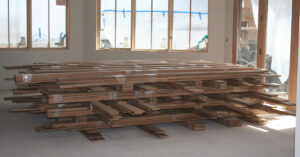How to acclimate hardwood flooring
Posted: September 30, 2024Updated 6/27/2025
Author – Ryan Palma Owner/CEO Sustainable Lumber Co.
Click on this link for more information, photo’s, and pricing on our wide selection of hardwood flooring, or to contact us for a pricing quote.
Do I need to acclimate my hardwood floor?
 When it comes to installing hardwood flooring, one of the most overlooked yet crucial steps is acclimation. This process isn’t just about following the rules; it’s about ensuring your investment in beautiful hardwood floors lasts for decades. Here’s a guide on why hardwood flooring acclimation is necessary and how to do it right.
When it comes to installing hardwood flooring, one of the most overlooked yet crucial steps is acclimation. This process isn’t just about following the rules; it’s about ensuring your investment in beautiful hardwood floors lasts for decades. Here’s a guide on why hardwood flooring acclimation is necessary and how to do it right.
Why Acclimate Your Hardwood Flooring?
Moisture Content: Wood is hygroscopic, meaning it absorbs and releases moisture from its environment. If the flooring isn’t given time to adjust to your home’s humidity, you might end up with floors that buckle or shrink as they expand and contract.
Temperature Adjustment: Just like moisture, temperature changes can affect wood. Acclimating helps the wood adjust to the temperature of your home, preventing issues like warping or splitting.
How to Acclimate Your Hardwood Flooring
Choose the Right Location: Place your hardwood flooring in the room where it will be installed or in a space with similar environmental conditions. This ensures the wood will adjust to the specific climate of its final resting place.
How Long Does Hardwood Flooring Need To Acclimate? Most experts recommend at least 5 days and as long as 14 days for wood flooring to acclimate. The duration of acclimation depends on factors such as the width of the boards, a different climate from where it originated, and whether it is a solid or engineered hardwood floor. Be sure to ask the manufacture about their recommended acclimation guidelines. If possible, install flooring during moderate seasons. Extreme summer heat or winter cold can make acclimation more challenging.
Control Environmental Conditions: Keep the temperature between 60-80°F (16-27°C). This range is comfortable for most homes and ideal for wood acclimation. Aim for a relative humidity of 35-55%. Using a humidifier or dehumidifier can help maintain this level. Unwrap the flooring and stack it flat. This allows air to circulate around each board, aiding in even moisture distribution.
Post-Installation Care: After installation, give your floors a few days to settle before placing heavy furniture or covering them with rugs. This helps prevent any immediate stress on the wood.
Special Considerations: While a solid hardwood floor needs careful acclimation, an engineered floor might have different requirements. Always check the manufacturer’s guidelines. Some flooring comes prefinished that might affect how you acclimate, Again, refer to the manufacturer’s instructions.
Conclusion
Acclimating your hardwood flooring isn’t just a step in the installation process; it’s a critical one. By allowing your floors to adjust to their new environment, you’re ensuring they look beautiful and function well for years to come. Remember, every type of wood and finish might have specific needs, so always consult the manufacturer’s recommendations. With proper acclimation, your hardwood floors will not only enhance your home’s aesthetic but also stand the test of time.
Contact Us:
Our knowledgeable and educated staff is here to answer any additional questions you may have. Please call us today for a free quote: Ph# 406.642.7120 or click here to submit an inquiry online. We look forward to working with you on your next project!

